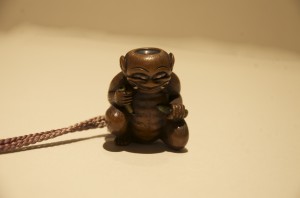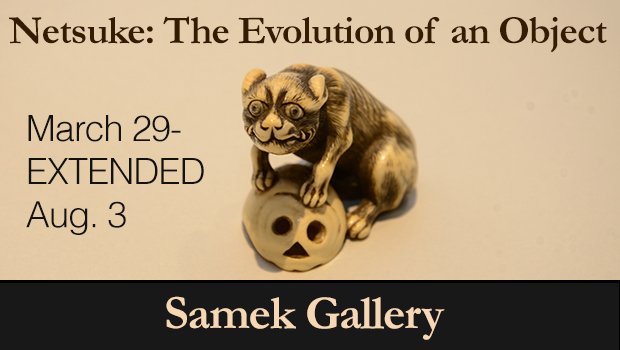
March 25 – EXTENDED August 3, 2014
Samek Gallery
Netsuke were developed as toggles in the seventeenth century to hold lacquer boxes in the sashes of kimonos. Evolved from simple tools, netsuke developed into intricate works indicative of fashion, class, and culture. These objects and their continuously evolving function call into question the separation of Art, Craft, and Fashion.
Netsuke provide a troubling predicament in when attempting to classify them as objects. Developed from simple belt rings used to hold pouches, thus the ancestry of Netsuke can be traced from tools. However an aesthetic focus and level of craftsman began to change the agency of these objects. The physical function of the object as a toggle remained an important factor. This regulated Netsuke to act as a craft. Netsuke held a close relationship in adorning the human body. It was not designed to accentuate the human body. This is in line with Japanese fashion’s relation with the human body. However while most craft is atheistically dependent on its functional form, Netsuke is unique. To remain functional it requires two connected openings in which to thread string. This gifted creators with the freedom to explore a wide range of forms and function. To a degree size may have posed a limitation as well as the as their own technical abilities. This contributed to the ongoing evolution of Netsuke. When Japonisme overtook the West in the late 19th-early 20th century all things Japanese became valued collector items. Netsukes were active pieces amidst this collection craze. For collectors these objects no longer served as objects with a physical function, but as purely aesthetic marvels. From the hands of individual collectors to the museum vaults Netsuke have remained a staple in art collections. However, these objects have gained a very small amount recognition outside the art market. A number of factors have played into this lack of attention. The influence of Netsuke on western artists is less visually striking and direct than that of woodblock prints. Netsuke does not have the notoriety in Japan when compared to many of its contemporary tangent objects.
-Guest Curator: Frank Fina, Samek Gallery Fellow

